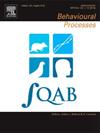Predation risk in two Patagonian Liolaemus lizards: Similar escape behaviour in different environmental contexts
IF 1.3
4区 生物学
Q4 BEHAVIORAL SCIENCES
引用次数: 0
Abstract
Prey species may assess the risk of being preyed upon and consequently decide adequate antipredator behaviours that increase their probability of survival. Predation risk is expected to increase with predation pressure, and conversely, to decrease with habitat complexity. Additionally, the colour pattern of the prey may also influence predation risk and conspicuous animals may experience higher risk than cryptic ones. Here we studied escape behaviour of Liolaemus kolengh and L. zullyae, two Patagonian lizard species occurring in habitats with different complexity and abundance of predators. Additionally, they exhibit sexual dichromatism with colourful males and cryptic females. We predicted that both species would show similar escape behaviour, with males showing more intense responses than females. In the field, we simulated predation events and registered flight initiation distance (FID) and refuge distance (RD), two escape behaviour variables related to predation risk in lizards. As expected, both species showed similar FID and RD, which may be explained by the combination of high abundance of predators-high complexity at the habitat of L. zullyae, and low abundance of predators-low complexity at the site of L. kolengh, but also by similar availability and use of rocks as refuges by the species. Intra-specifically, sex influenced FID of L. kolengh lizards only when perching on bare ground, with females allowing closer approaches than males, probably related to a lower detectability against this background. We suggest that environmental variables, microhabitat use and intrinsic characteristics, such as coloration and sex may interact to influence predation risk and escape behaviour.
两种巴塔哥尼亚Liolaemus蜥蜴的捕食风险:不同环境下相似的逃跑行为。
被捕食的物种可能会评估被捕食的风险,从而决定适当的反捕食行为,以增加它们的生存几率。捕食风险随着捕食压力的增加而增加,相反,随着栖息地复杂性的增加而降低。此外,猎物的颜色图案也可能影响捕食风险,显眼的动物可能比隐蔽的动物经历更高的风险。本文研究了两种巴塔哥尼亚蜥蜴(Liolaemus kolengh)和L. zullyae的逃跑行为,这两种蜥蜴生活在不同复杂程度和捕食者丰度的栖息地。此外,它们还表现出性别上的二色性,有色彩鲜艳的雄性和神秘的雌性。我们预测这两个物种会表现出相似的逃避行为,雄性比雌性表现出更强烈的反应。在野外,我们模拟了蜥蜴的捕食事件,并记录了与捕食风险相关的两个逃跑行为变量——飞行起始距离(FID)和避难距离(RD)。正如预期的那样,两种物种的FID和RD相似,这可能是由于在L. zullyae栖息地捕食者的高丰度-高复杂性和L. kolengh栖息地捕食者的低丰度-低复杂性的结合,以及物种对岩石的可利用性和利用程度相似。在特异性内,性别仅在栖息在裸露地面时影响L. kolengh蜥蜴的FID,雌性比雄性更接近,可能与在这种背景下较低的可探测性有关。我们认为,环境变量、微生境的使用和内在特征(如颜色和性别)可能相互作用,影响捕食风险和逃跑行为。
本文章由计算机程序翻译,如有差异,请以英文原文为准。
求助全文
约1分钟内获得全文
求助全文
来源期刊

Behavioural Processes
生物-动物学
CiteScore
2.70
自引率
7.70%
发文量
144
审稿时长
4-8 weeks
期刊介绍:
Behavioural Processes is dedicated to the publication of high-quality original research on animal behaviour from any theoretical perspective. It welcomes contributions that consider animal behaviour from behavioural analytic, cognitive, ethological, ecological and evolutionary points of view. This list is not intended to be exhaustive, and papers that integrate theory and methodology across disciplines are particularly welcome.
 求助内容:
求助内容: 应助结果提醒方式:
应助结果提醒方式:


